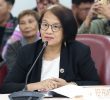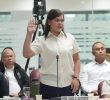Prof. Ali Ayub, the secretary-general of the National Ulama Conference of the Philippines in the Zambasulta Region said his group and civil society organizations offered viable options to the Crisis Management Committee to break the standoff sooner between the Moro National Liberation Front (MNLF) followers of Chairman Nur Misuari, and state security forces in Zamboanga.
By JOHN RIZLE L. SALIGUMBA
Davao Today
Davao City — An influential group of Muslim religious could have dissipated the tension and prevented the bloodbath between Moro guerrillas and the government armed forces on the first week of the standoff in Zamboanga City this month.
That is, if they were only heard and given due attention when they tried to offer mediation.
Prof. Ali Ayub, the secretary-general of the National Ulama Conference of the Philippines in the Zambasulta Region said his group and civil society organizations offered viable options to the Crisis Management Committee to break the standoff sooner between the Moro National Liberation Front (MNLF) followers of Chairman Nur Misuari, and state security forces in Zamboanga.
Ayub said the suggestions of interventions were offered as early as September 10, the second day of the standoff.
“Hindi sana lumala (It could have been prevented from being aggravated). The spiritual adviser of the MNLF is part of the group willing to mediate in the name of the Darul Ifta’ (Supreme Council for Islamic Preaching and Guidance in Region IX and Palawan),” he said.
The supreme council is also known as the “house of jurisprudence” in the Islamic world, and is responsible for periodic issuances of fatwah, or ruling, on appropriate or adaption of new conduct of practices.
“It was a big group of 50 ulama. The muftis of Basilan, Sulu, Tawi-Tawi are here,” Ayub said. The Darul Ifta’ even held a consultative assembly in a hotel in Zamboanga last September 12, 2013 the fourth day of the standoff.
He said one Shaykh Abdulbaki Abubakar, the Mufti of Region IX, “is the spiritual adviser of the MNLF. They will listen to him”.
“We talked to him and he said he can talk to them [the MNLF] but in the name of the Darul Ifta,” he said.
The ulama are religious leaders equivalent to the Christians’ bishops, and muftis are Islam’s higest-ranking governing leaders.
He said the group had relayed its plan to the CMC via Governor Mujiv Hataman of the Autonomous Region for Muslim Mindanao “as they invited him to the meeting of the group”. But, he said, there was no response from the CMC.
“Ang sinabi nalang sa amin, meron silang plano nila. Thinking na better siguro yun, nagconcentrate nalang kami sa relief, sa mga evacuees (We were told that they have their own plan. Thinking that they have a better plan, we opted to concentrate in the relief operations),” he said.
After they sensed that there was no improvement in the standoff, the Darul Ifta’ released a statement last September 13, the fifth day of the conflict.
“We hope and pray for the peaceful resolution of this conflict. We call on both parties, the Government and the MNLF to open the avenue for peaceful negotiationin order to end the conflict. To start the process, we ask both parties to mutually call for immediate cessation of hostilities or ceasefire. We also call on both parties to seriously take into account the sufferings of the evacuees and all other persons affected by the standoff,” a part of the Darul Ifta’ statement said.
Ayub said that the “ceasefire” in the statement means “humanitarian ceasefire” as there were still hostages.
Ayub disclosed that they were informed by friends from another group who wanted to intervene that the CMC had agreed to their proposal.
“In fact nag form na sila ng negotiating panel na kasali ang isang kasama naming Ulama, siya ang representative doon sa nego panel. Ready na yun sila, all of a sudden nag change ang decision (In fact a negotiating panel was formed including an Ulama representing our group. They were ready but all of a sudden the decision changed),” said Ayub.
Military operation from Day 1
“Nawala yung panel na yun pagdating ni [Interior Secretary] Mar [Roxas](The panel was dissolved when ni [Interior Secretary] Mar [Roxas] arrived),” he said, but clarified that Mayor Ma. Isabelle Climaco was already amenable to the mandate of the negotiating panel.
It was during the arrival of Roxas and President Aquino that the term “calibrated response” came out.
President Aquino also made it clear on his visit to troops in the Western Mindanao Command, “It was a military operation from day one”.
It was after the President’s speech that journalists themselves witnessed a number of tanks and hundreds of soldiers tried an assault the MNLF stronghold in Lustre Street in downtown Zamboanga.
The assault that day, September 13, was not successful.
A 60-year old woman hostage, who escaped later from the MNLF, said that it was also that day when they saw dove-shaped leaflets falling from the sky and thought it signaled the end of their plight.
Manang, not her real name, said some MNLF guards talked about a ceasefire but she was not sure what it meant for them as hostages. “Some of us were jumping with joy. We shook each other’s hand and we shook the hands of our MNLF captors,” said Manang.
However, many of them were told to stand in the open, under the heat of the sun.
“They told us to shout ‘ceasefire, ceasefire, wag magpaputok’ but I was not included because I am too weak to stand in the heat,” Manang said.
One of those who were outside, she said, saw a member of the media and thought that it was indeed a “ceasefire.”
Government bullets hit hostages
“Tanks came in and the shooting started. It was then that many of us hostages were killed,” she said.
Unknown to the media who were there during the assault September 13, hostages were in the streets and in the surrounding buildings to which the assault is directed. She could not recall by now how many hostages were killed but she said she saw them hit by bullets.
While in captivity, Manang is also bewildered as to why bullets from state troops seemed to be heading in their direction.
“The KGK building where the rebels are hiding is adjacent to where we are. But, the bullets and bombs seem to be hitting the building where we were held. Are our troops trained?” she asked.
Such accounts of civilians still trapped inside the MNLF-held areas “best described what would happen if the conflict [now on its 18th day], gets extended and aggravated”, Ayub said, who accused both parties of having “violated the right to life.”
Ayub criticized “national (political) figures” who he said capitalized on their presence in the conflict area “to position themselves and to project”.
“It’s not solving the problem. Sorry to say, the crisis management committee is in crisis,” he said. He believed that even the military has become frustrated “as their expertise was not given attention and which could have saved even the soldiers’ lives”.
“Politics ang nagdecide eh (It was Politics which decided),” he said.
He emphasized that their stand on the “Cabatangan formula” – derived from the November 2001 incident in Barangay Cabatangan in Zamboanga where MNLF fighters were allowed to escape in exchange for the release of hostages – was under the condition that government would pursue the MNLF and file charges.
“Sinabi namin pwede naman i-apply yung Cabatangan Formula. Pero yung exchange ng hostages and then walang case filed against them, hindi yun ang position namin. Yung paghostage, pagpatay ng mga civilians, I think dapat merong kaso (We told them that the Cabatangan Formula could be applied. However, the exchange of hostages and then that no cases would be filed against them is not our position. Cases should be filed against them (MNLF) for taking hostage and the death of civilians,” he said. The arrest may be done later “sa ibang lugar na walang hostage. Habulin nila sa Jolo, sa bundok (in a different place where there is no hostage. Chase them in Jolo, in the mountains,” he said.
Diversion?
The ulama and the muftis said they also questioned the timing of the incident.
“[First] At the height ng pork barrel. Second, Martial Law anniversary. Third, September 11 anniversary [of the New York World Trade Center bombings]. Di ba? (Right?) Kung titingnan mo ang pattern, anong nangyari sa Sabah? Parang the same eh. So who is behind the scene? Ang tingin namin, different and motive, different ang intention but the pattern is the same (If you look at the pattern, is it not he same as what happened in Sabah? It seems the same. We think that the motive is different, the intention is different but the pattern is the same),” Ayub asked.
He said that even though the CMC would not admit it, their handling of the situation clearly shows that the cultural side of the conflict was not considered.
“Halimbawa, ito yung mga taong kung lalaban, lalaban yan. Pero kung magnegotiate, mag negotiate yan. Hindi yan susurrender (For example, these people are Tausugs, they will fight if they need to fight. But if they would negotiate, they would negotiate. They will not surrender),” he said.
Ayub said that even the ones who were tapped to contact the rebels asked for a “clearance” for fear that they will be implicated with the rebels.
Moreover, he said, the trust of the MNLF rebels may have been lost after certain agreements were not followed upon the release of hostage priest Fr. Michael Ufana.
“Part ng agreement na sa paglabas ni Fr. Ufana, kunin yung mga patay at mga wounded nila. Nakuha lang ang patay, ang wounded hindi nakuha. Most likely, namatay na yung wounded. Humingi din sila ng water at food. Hindi nakarating yung food, hindi din bumalik si Fr. Ufana. Kumbaga they were betrayed (Part of the agreement that if Fr. Ufana is released, their dead and wounded (MNLF) would be brought out, but the wounded were not taken. Most like, the wounded already died. They also asked for food and water. The food did not arrive, Fr. Ufana did not also return. It was like they were betrayed,” said Ayub adding that it dissipated what trust left the MNLF had in the negotiations.
Probe the incident
Meeting among themselves, the CSOs already to call on government to investigate the handling of incident, including Misuari “and whoever is behind him”, Ayub said.
As of 3:00 pm of September 26, the conflict already claimed 149 lives, 126 of which were rebels, 23 were Army and the police, and 12 were civilians, according to the twitter account of the Armed Forces of the Philippines.
Mayor Climaco also said that as of 10 am Thursday, 18,297 families, or 101,259 people, have evacuated to 44 evacuation centers.
The local government pegged the economic losses at P5 billion.
To contain the losses and show business must return to normalcy, the mayor’s office said by Thursday “most small sari-sari stores, shopping malls including Mindpro, fast food chains and hardware stores located within the city’s commercial district have opened starting yesterday [Thursday]”.
“[Thirty] commercial banks, mostly located outside the commercial district, have already resumed operations with limited banking hours—some close at 12 noon while others close at 2pm,” said the statement. (John Rizle L. Saligumba/davaotoday.com)
beng climaco, mar roxas, mnlf, nur misuari, US forces Philippines, zambo, zamboanga, zamboanga hermosa, zamboanga standoff









